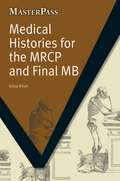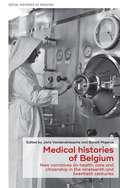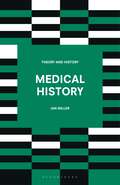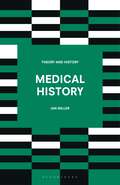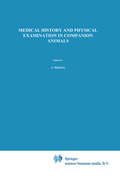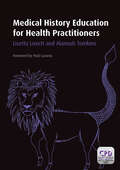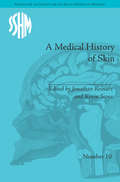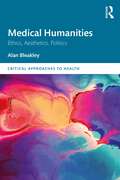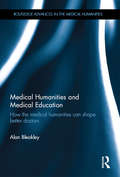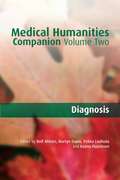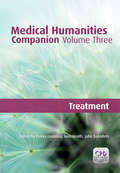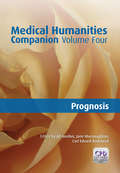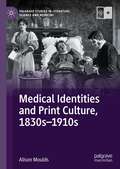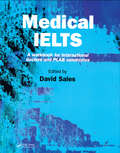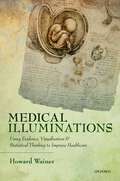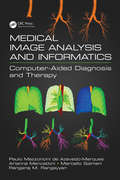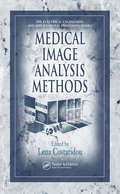- Table View
- List View
Medical Histories for the MRCP and Final MB (MasterPass)
by Iqbal Khan Zafar IqbalTaking a patient's medical history is a vital skill often overlooked by junior doctors and medical students, leading to a worryingly high failure rate in the PACES and OSCE exams. Don't be caught out! This book has been specifically designed to give you invaluable guidance and practice for taking medical histories. It features 50 complete case studies, including referral letters, medical histories, suggested data gathering methods, points to consider, warning signs, management of uncomfortable topics and differential diagnosis. With a focus on the importance and benefits of role-play in revision, this concise and easy to read format provides the study aid for Membership of the Royal College of Physicians (MRCP) candidates sitting their Objective Structured Clinical Examination (OSCE) and Practical Assessment of Clinical Examination Skills (PACES) examinations. It is also of great benefit to undergraduates approaching their final year examinations.
Medical histories of Belgium: New narratives on health, care and citizenship in the nineteenth and twentieth centuries (Social Histories of Medicine #50)
by David CantorMedical histories of Belgium reshapes Belgian history of medicine by bringing together a new generation of scholars. Going beyond a chronological narrative, the book offers new insights by questioning classic themes of the history of medicine: physicians, institutions and the nation state. While retracing specific Belgian characteristics, it also engages with broader European developments in the nineteenth and twentieth centuries. Medical histories of Belgium will appeal to Historians of Belgium in various subfields, especially cultural history and political history and medical historians and medical practitioners seeking the historical context of their activities.
Medical histories of Belgium: New narratives on health, care and citizenship in the nineteenth and twentieth centuries (Social Histories of Medicine #50)
by David CantorMedical histories of Belgium reshapes Belgian history of medicine by bringing together a new generation of scholars. Going beyond a chronological narrative, the book offers new insights by questioning classic themes of the history of medicine: physicians, institutions and the nation state. While retracing specific Belgian characteristics, it also engages with broader European developments in the nineteenth and twentieth centuries. Medical histories of Belgium will appeal to Historians of Belgium in various subfields, especially cultural history and political history and medical historians and medical practitioners seeking the historical context of their activities.
Medical History
by Ian MillerThis introductory textbook presents medical history as a theoretically rich discipline, one that constantly engages with major social questions about ethics, bodies, state power, disease, public health and mental disorder. Providing both instructors and students with an account of the changing nature of medical history research since it first emerged as a distinct discipline in 19th century Germany, this essential guide covers the theoretical development of medical history and evaluates the various approaches adopted by doctors, historians and sociologists. Synthesising historiographical material ranging from the 19th to 21st centuries, this is an ideal resource for postgraduate students from History and History of Medicine degrees taking courses on historiography, the theory of history and medical history.
Medical History: Hunger Strikes, Prisons And Medical Ethics, 1909 1974 (Theory and History)
by Ian MillerThis introductory textbook presents medical history as a theoretically rich discipline, one that constantly engages with major social questions about ethics, bodies, state power, disease, public health and mental disorder. Providing both instructors and students with an account of the changing nature of medical history research since it first emerged as a distinct discipline in 19th century Germany, this essential guide covers the theoretical development of medical history and evaluates the various approaches adopted by doctors, historians and sociologists.Synthesising historiographical material ranging from the 19th to 21st centuries, this is an ideal resource for postgraduate students from History and History of Medicine degrees taking courses on historiography, the theory of history and medical history.
Medical History and Physical Examination in Companion Animals
by H. W. Vries A. Rijnberkcreation no falsification falsification Tl rejected creation etc. Figure 1-1 delivers such a result that the theory must be seen as an extension of Popper's rational proce discarded. In this way we come at the same time dure for theory elimination. to the border between science and nonscience: a Popper's naive falsifiability knows only one theory is scientific if it is falsifiable. It is thus way, the elimination of what is weak. The so not scientific to bring additional evidence to phisticated falsifiability, in contrast, knows only bear in vindication of the theory; the theory elimination in combination with the acceptance would thereby take on the character of an un of an alternative. According to sophisticated fal challengeable certainty of belief ('religion'). sifiability, a scientific theory T r is only aban Following Popper, others such as Kuhn, with doned if its place is taken by another theory T2 his paradigm theory, have considerably extended which has the following three characteristics: 1 the range of thought over what is scientific and T 2 has more empirical content than TI; the new what is not.
Medical History Education for Health Practitioners
by Lisett Lovett Alannah Tomkins'Twenty-first century medicine is just the current stage of a never-ending journey of tremendous complexity. Those of us who are fortunate enough to practise in this day and age do so in ways that are themselves the results of huge changes over many centuries - advances in areas such as medication and surgical and imaging techniques and developments in our understanding of the human body and its attendant threats through genetics. Add to that list the huge social and societal changes in public health, attitudes to illness and changes in ethical viewpoints, and we find ourselves at the current forefront of medical evolution but nowhere near the end of this particular journey.' From the Foreword by Paul Lazarus This fascinating book brings to life the history of medicine in Britain since 1600. Throughout the historical account the authors cover mainstream clinical issues but also make reference to the importance of literature and art, presenting a wide-ranging view of the past. It also incorporates milestones in other cultures and epochs, where appropriate, for a balanced overview. The concise, self-contained sections are a joy to read and can be easily dipped into. The majority of chapters include suggested questions for students, assisting group discussion. It is ideal for medical and healthcare course organisers, lecturers and tutors who require a rapid resource of information in their subject area - be it cardiovascular disease, emergency medicine or child protection - to provide context, interest and entertainment for their students. It is also highly recommended as the basis for a programme of seminars on the history of medicine.
Medical History Education for Health Practitioners
by Lisett Lovett Alannah Tomkins'Twenty-first century medicine is just the current stage of a never-ending journey of tremendous complexity. Those of us who are fortunate enough to practise in this day and age do so in ways that are themselves the results of huge changes over many centuries - advances in areas such as medication and surgical and imaging techniques and developments in our understanding of the human body and its attendant threats through genetics. Add to that list the huge social and societal changes in public health, attitudes to illness and changes in ethical viewpoints, and we find ourselves at the current forefront of medical evolution but nowhere near the end of this particular journey.' From the Foreword by Paul Lazarus This fascinating book brings to life the history of medicine in Britain since 1600. Throughout the historical account the authors cover mainstream clinical issues but also make reference to the importance of literature and art, presenting a wide-ranging view of the past. It also incorporates milestones in other cultures and epochs, where appropriate, for a balanced overview. The concise, self-contained sections are a joy to read and can be easily dipped into. The majority of chapters include suggested questions for students, assisting group discussion. It is ideal for medical and healthcare course organisers, lecturers and tutors who require a rapid resource of information in their subject area - be it cardiovascular disease, emergency medicine or child protection - to provide context, interest and entertainment for their students. It is also highly recommended as the basis for a programme of seminars on the history of medicine.
A Medical History of Skin: Scratching the Surface (Studies for the Society for the Social History of Medicine)
by Kevin Patrick SienaDiseases affecting the skin have tended to provoke a response of particular horror in society. This collection of essays uses case studies to chart the medical history of skin from the eighteenth to the twentieth century.
A Medical History of Skin: Scratching the Surface (Studies for the Society for the Social History of Medicine #10)
by Kevin Patrick SienaDiseases affecting the skin have tended to provoke a response of particular horror in society. This collection of essays uses case studies to chart the medical history of skin from the eighteenth to the twentieth century.
Medical Humanities: Ethics, Aesthetics, Politics (Critical Approaches to Health)
by Alan BleakleyThis ground-breaking book sets out a fresh vision for a future medical education by providing a radical reconceptualisation of the purposes of medical humanities through a lens of critical health psychology and liberatory pedagogy. The medical humanities are conceived as translational media through which reductive, instrumental biomedicine can be raised in quality, intensity, and complexity by embracing ethical, aesthetic, political, and transcendental values. This translation occurs through innovative use of metaphor. A note of caution is offered – that the medical humanities too can be instrumental and reductive if not framed well. Drawing on major theorists such as Michel Foucault and Jacques Rancière and bringing together insights from diverse but inter-related fields, Bleakley focuses on the "ills" of contemporary biomedicine and medical education, and the need for reconceptualisation, which – it is argued – the translational medical humanities have the potential to accomplish. Current instrumental approaches to medical humanities, embracing communication skills training and narrative-based medicine, have failed to address the chronic symptoms suffered by medicine. These include resort to closed, functional systems thinking rather than embracing dynamic, complex, open, and adaptive systems thinking; lack of democratic habits in medical culture, compromising patient safety and care; the production of insensibility rather than deepening of sensibility in medical education; a lack of attention to ethics, aesthetics, and politics where the instrumental is privileged; and a lack of critical reflexivity in revisioning habitual practices. Through persuasive argument, Bleakley sets out a more radical manifesto for the role the arts and humanities might play in medical/healthcare education and offers a new approach based on curriculum process rather than syllabus content, to recuperate aesthetic sensibilities, discernment, and affect in medicine. The book will appeal to medical and healthcare educators, medical and health humanities scholars, engaged clinicians, social scientists drawing on critical theory, and arts and humanities practitioners engaging with medical and healthcare themes.
Medical Humanities: Ethics, Aesthetics, Politics (Critical Approaches to Health)
by Alan BleakleyThis ground-breaking book sets out a fresh vision for a future medical education by providing a radical reconceptualisation of the purposes of medical humanities through a lens of critical health psychology and liberatory pedagogy. The medical humanities are conceived as translational media through which reductive, instrumental biomedicine can be raised in quality, intensity, and complexity by embracing ethical, aesthetic, political, and transcendental values. This translation occurs through innovative use of metaphor. A note of caution is offered – that the medical humanities too can be instrumental and reductive if not framed well. Drawing on major theorists such as Michel Foucault and Jacques Rancière and bringing together insights from diverse but inter-related fields, Bleakley focuses on the "ills" of contemporary biomedicine and medical education, and the need for reconceptualisation, which – it is argued – the translational medical humanities have the potential to accomplish. Current instrumental approaches to medical humanities, embracing communication skills training and narrative-based medicine, have failed to address the chronic symptoms suffered by medicine. These include resort to closed, functional systems thinking rather than embracing dynamic, complex, open, and adaptive systems thinking; lack of democratic habits in medical culture, compromising patient safety and care; the production of insensibility rather than deepening of sensibility in medical education; a lack of attention to ethics, aesthetics, and politics where the instrumental is privileged; and a lack of critical reflexivity in revisioning habitual practices. Through persuasive argument, Bleakley sets out a more radical manifesto for the role the arts and humanities might play in medical/healthcare education and offers a new approach based on curriculum process rather than syllabus content, to recuperate aesthetic sensibilities, discernment, and affect in medicine. The book will appeal to medical and healthcare educators, medical and health humanities scholars, engaged clinicians, social scientists drawing on critical theory, and arts and humanities practitioners engaging with medical and healthcare themes.
Medical Humanities and Medical Education: How the medical humanities can shape better doctors (Routledge Advances in the Medical Humanities)
by Alan BleakleyThe field of the medical humanities is developing rapidly, however, there has also been parallel concern from sceptics that the value of medical humanities educational interventions should be open to scrutiny and evidence. Just what is the impact of medical humanities provision upon the education of medical students? In an era of limited resources, is such provision worth the investment? This innovative text addresses these pressing questions, describes the contemporary territory comprising the medical humanities in medical education, and explains how this field may be developed as a key medical education component for the future. Bleakley, a driving force of the international movement to establish the medical humanities as a core and integrated provision in the medical curriculum, proposes a model that requires collaboration between patients, artists, humanities scholars, doctors and other health professionals, in developing medical students’ sensibility (clinical acumen based on close noticing) and sensitivity (ethical, professional and humane practice). In particular, this text focuses upon how medical humanities input into the curriculum can help to shape the identities of medical students as future doctors who are humane, caring, expressive and creative – whose work will be technically sound but considerably enhanced by their abilities to communicate well with patients and colleagues, to empathise, to be adaptive and innovative, and to act as ‘medical citizens’ in shaping a future medical culture as a model democracy where social justice is a key aspect of medicine. Making sense of the new wave of medical humanities in medical education scholarship that calls for a ‘critical medical humanities’, Medical Humanities and Medical Education incorporates a range of case studies and illustrative and practical examples to aid integrating medical humanities into the medical curriculum. It will be important reading for medical educators and others working with the medical education community, and all those interested in the medical humanities.
Medical Humanities and Medical Education: How the medical humanities can shape better doctors (Routledge Advances in the Medical Humanities)
by Alan BleakleyThe field of the medical humanities is developing rapidly, however, there has also been parallel concern from sceptics that the value of medical humanities educational interventions should be open to scrutiny and evidence. Just what is the impact of medical humanities provision upon the education of medical students? In an era of limited resources, is such provision worth the investment? This innovative text addresses these pressing questions, describes the contemporary territory comprising the medical humanities in medical education, and explains how this field may be developed as a key medical education component for the future. Bleakley, a driving force of the international movement to establish the medical humanities as a core and integrated provision in the medical curriculum, proposes a model that requires collaboration between patients, artists, humanities scholars, doctors and other health professionals, in developing medical students’ sensibility (clinical acumen based on close noticing) and sensitivity (ethical, professional and humane practice). In particular, this text focuses upon how medical humanities input into the curriculum can help to shape the identities of medical students as future doctors who are humane, caring, expressive and creative – whose work will be technically sound but considerably enhanced by their abilities to communicate well with patients and colleagues, to empathise, to be adaptive and innovative, and to act as ‘medical citizens’ in shaping a future medical culture as a model democracy where social justice is a key aspect of medicine. Making sense of the new wave of medical humanities in medical education scholarship that calls for a ‘critical medical humanities’, Medical Humanities and Medical Education incorporates a range of case studies and illustrative and practical examples to aid integrating medical humanities into the medical curriculum. It will be important reading for medical educators and others working with the medical education community, and all those interested in the medical humanities.
Medical Humanities Companion: v. 2
by Rolf Ahlzen Martyn Evans Raimo PuustWhen a person falls ill, their experience changes - sometimes in a very minor and transient way, sometimes in a decisive and lasting one. 'Diagnosis' is often seen as the process of scientifically and objectively identifying the causes of this subjective experience, but is the process and meaning of 'diagnosis' really as simple as this implies? As this volume of The Medical Humanities Companion argues, diagnoses are an answer to complex human needs that spring from being ill, and are in turn a complex, culturally mediated interaction between individuals, scientific discoveries, social negotiation and historical change. This volume makes visible the complexities and ambiguities involved in giving and receiving diagnoses, and how they shape and are shaped by views on what is real and acceptable, and how people relate to the phenomena of illness.
Medical Humanities Companion: v. 2
by Rolf Ahlzen Martyn Evans Raimo PuustWhen a person falls ill, their experience changes - sometimes in a very minor and transient way, sometimes in a decisive and lasting one. 'Diagnosis' is often seen as the process of scientifically and objectively identifying the causes of this subjective experience, but is the process and meaning of 'diagnosis' really as simple as this implies? As this volume of The Medical Humanities Companion argues, diagnoses are an answer to complex human needs that spring from being ill, and are in turn a complex, culturally mediated interaction between individuals, scientific discoveries, social negotiation and historical change. This volume makes visible the complexities and ambiguities involved in giving and receiving diagnoses, and how they shape and are shaped by views on what is real and acceptable, and how people relate to the phenomena of illness.
Medical Humanities Companion, Volume 3: Treatment
by Pekka Louhiala Iona Heath John SaundersThis third volume in the Companion to Medical Humanities series considers the concept of treatment as an active process which produces an outcome, be it effective, inappropriate or inadequate. It invites the reader to examine the relevance of the patients' belief in any given treatment and their confidence in the practitioner. Against a person-cent
Medical Humanities Companion, Volume 4
by Jill Gordon Jane MacNaughton Carl Edvard RudebackThis fourth volume in the Companion to Medical Humanities series contemplates the challenge of the prognosis, of looking ahead, wondering what will happen, and attempting to make sense of life and death.
Medical Identities and Print Culture, 1830s–1910s (Palgrave Studies in Literature, Science and Medicine)
by Alison MouldsThis book examines how the medical profession engaged with print and literary culture to shape its identities between the 1830s and 1910s in Britain and its empire. Moving away from a focus on medical education and professional appointments, the book reorients attention to how medical self-fashioning interacted with other axes of identity, including age, gender, race, and the spaces of practice. Drawing on medical journals and fiction, as well as professional advice guides and popular periodicals, this volume considers how images of medical practice and professionalism were formed in the cultural and medical imagination. Alison Moulds uncovers how medical professionals were involved in textual production and consumption as editors, contributors, correspondents, readers, authors, and reviewers. Ultimately, this book opens up new perspectives on the relationship between literature and medicine, revealing how the profession engaged with a range of textual practices to build communities, air grievances, and augment its cultural authority and status in public life.
Medical IELTS: A Workbook for International Doctors and PLAB Candidates
by David SalesIn which occupation are you?' 'From how long have you been smoking?' 'Do you take any alcohol/drinks?' All overseas qualified doctors who apply for registration in the UK must satisfy the General Medical Council that they have the necessary knowledge of English, by obtaining a satisfactory score in the International English Language Testing System (IELTS) examination. This interactive workbook provides a wide range of questions and answers on this subject, containing specific medical sections to address the common problems and pitfalls relating to vocabulary and fluency in everyday medical consultations. Overseas qualified doctors needing to take the IELTS examination in order to be eligible for the GMC PLAB examination, which is required for practice in the UK, will find this book essential for their study.
Medical IELTS: A Workbook for International Doctors and PLAB Candidates
by David SalesIn which occupation are you?' 'From how long have you been smoking?' 'Do you take any alcohol/drinks?' All overseas qualified doctors who apply for registration in the UK must satisfy the General Medical Council that they have the necessary knowledge of English, by obtaining a satisfactory score in the International English Language Testing System (IELTS) examination. This interactive workbook provides a wide range of questions and answers on this subject, containing specific medical sections to address the common problems and pitfalls relating to vocabulary and fluency in everyday medical consultations. Overseas qualified doctors needing to take the IELTS examination in order to be eligible for the GMC PLAB examination, which is required for practice in the UK, will find this book essential for their study.
Medical Illuminations: Using Evidence, Visualization and Statistical Thinking to Improve Healthcare
by Howard WainerIs it sensible to screen for breast or prostate cancer? Should the locations of cancer clusters be made available to the general public? When a doctor wants to perform major surgery and there's no chance for a second opinion, do you agree? The answers to these questions are not as black and white as they may first appear. Medical Illuminations presents thirteen contemporary medical topics, from the diminishing value of mammograms to how to decide if a hip needs to be replaced, to understanding cancer maps. In each case it illustrates how modern tools of statistical thinking and statistical graphics can illuminate our understanding. The goals are to solve some vexing problems that seem perplexing, and to make both the problems and their solutions clear to a non-technical audience. The aim is to ignite in the reader an understanding of statistical thinking, which, though subtle, can be learned without going through arcane mathematics. And, moreover, that learning about how to think in this way provides a huge payoff in the deeper understanding of our complex world.
Medical Image Analysis and Informatics: Computer-Aided Diagnosis and Therapy
by Paulo Mazzoncini de Azevedo-Marques Arianna Mencattini Marcello Salmeri Rangaraj M. RangayyanWith the development of rapidly increasing medical imaging modalities and their applications, the need for computers and computing in image generation, processing, visualization, archival, transmission, modeling, and analysis has grown substantially. Computers are being integrated into almost every medical imaging system. Medical Image Analysis and Informatics demonstrates how quantitative analysis becomes possible by the application of computational procedures to medical images. Furthermore, it shows how quantitative and objective analysis facilitated by medical image informatics, CBIR, and CAD could lead to improved diagnosis by physicians. Whereas CAD has become a part of the clinical workflow in the detection of breast cancer with mammograms, it is not yet established in other applications. CBIR is an alternative and complementary approach for image retrieval based on measures derived from images, which could also facilitate CAD. This book shows how digital image processing techniques can assist in quantitative analysis of medical images, how pattern recognition and classification techniques can facilitate CAD, and how CAD systems can assist in achieving efficient diagnosis, in designing optimal treatment protocols, in analyzing the effects of or response to treatment, and in clinical management of various conditions. The book affirms that medical imaging, medical image analysis, medical image informatics, CBIR, and CAD are proven as well as essential techniques for health care.
Medical Image Analysis and Informatics: Computer-Aided Diagnosis and Therapy
by Paulo Mazzoncini de Azevedo-Marques Arianna Mencattini Marcello Salmeri Rangaraj M. RangayyanWith the development of rapidly increasing medical imaging modalities and their applications, the need for computers and computing in image generation, processing, visualization, archival, transmission, modeling, and analysis has grown substantially. Computers are being integrated into almost every medical imaging system. Medical Image Analysis and Informatics demonstrates how quantitative analysis becomes possible by the application of computational procedures to medical images. Furthermore, it shows how quantitative and objective analysis facilitated by medical image informatics, CBIR, and CAD could lead to improved diagnosis by physicians. Whereas CAD has become a part of the clinical workflow in the detection of breast cancer with mammograms, it is not yet established in other applications. CBIR is an alternative and complementary approach for image retrieval based on measures derived from images, which could also facilitate CAD. This book shows how digital image processing techniques can assist in quantitative analysis of medical images, how pattern recognition and classification techniques can facilitate CAD, and how CAD systems can assist in achieving efficient diagnosis, in designing optimal treatment protocols, in analyzing the effects of or response to treatment, and in clinical management of various conditions. The book affirms that medical imaging, medical image analysis, medical image informatics, CBIR, and CAD are proven as well as essential techniques for health care.
Medical Image Analysis Methods
by Lena CostaridouTo successfully detect and diagnose disease, it is vital for medical diagnosticians to properly apply the latest medical imaging technologies. It is a worrisome reality that due to either the nature or volume of some of the images provided, early or obscured signs of disease can go undetected or be misdiagnosed. To combat these inaccuracies, diagno
